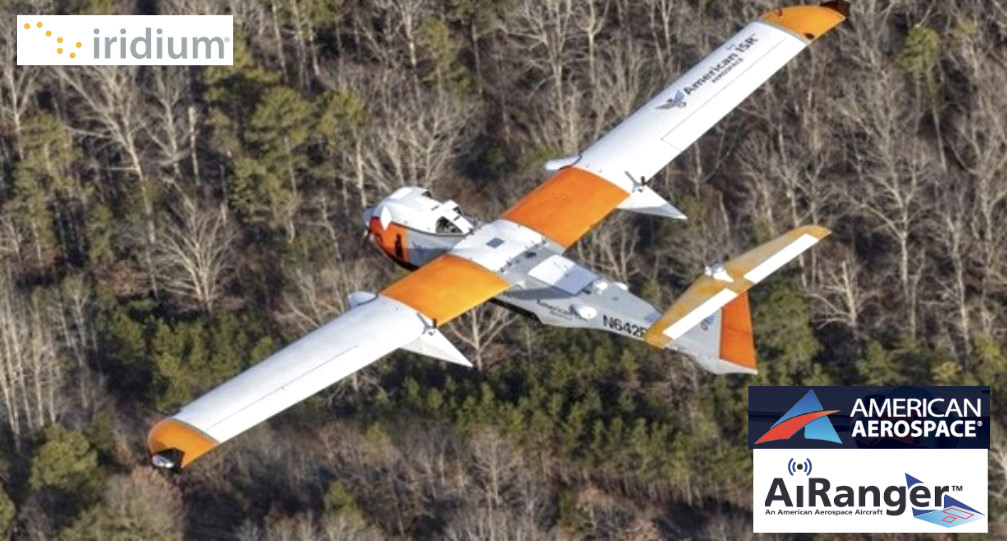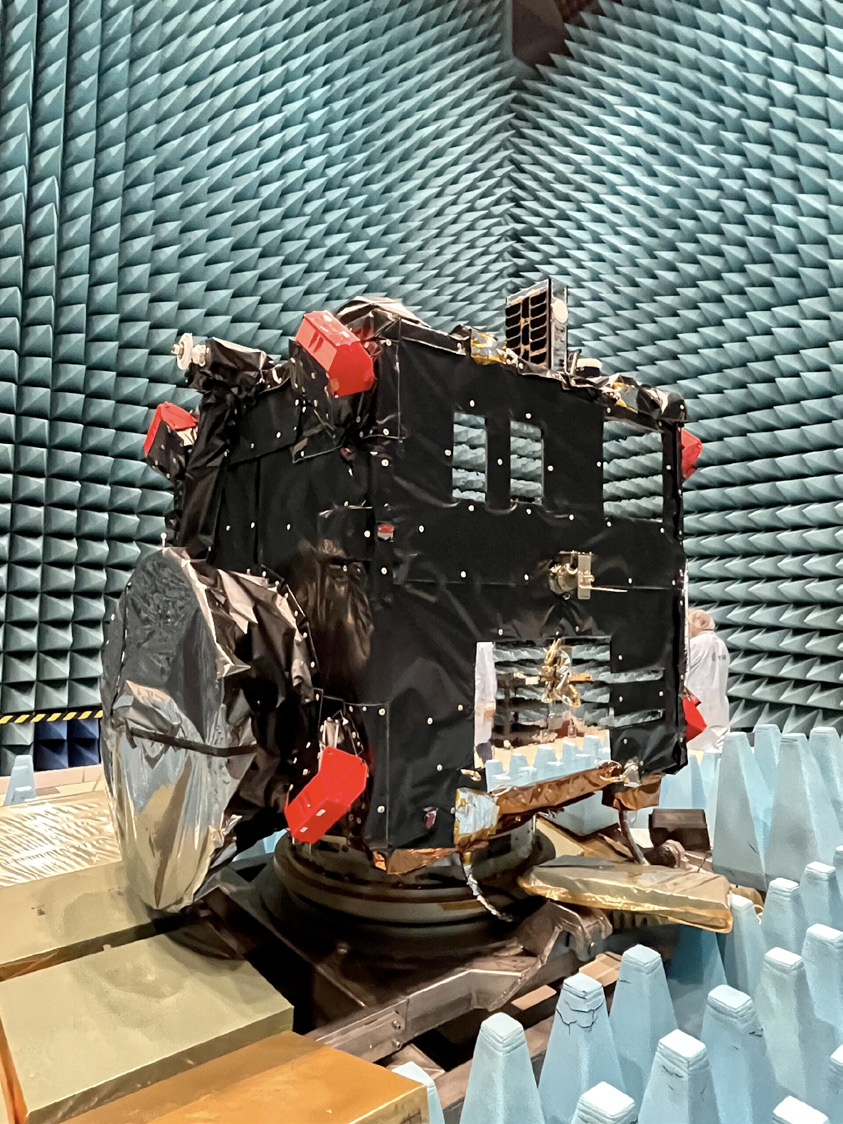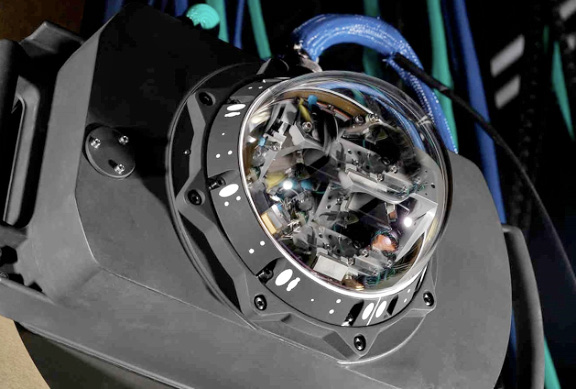Iridium Communications Inc. (Nasdaq: IRDM) has announced a historic development for uncrewed aerial systems (UAS) operations Beyond Visual Line Of Sight (BVLOS).
Iridium partner American Aerospace Technologies, Inc. (AATI) was granted a first-of-its-kind waiver from the U.S. Federal Aviation Administration (FAA) to conduct UAS surveillance of critical infrastructure in the San Joaquin Valley on behalf of a multinational oil and gas company. This waiver may serve as a tipping point for wider adoption of safe and scalable UAS operations in the National Airspace System (NAS).

Enabled by Iridium’s L-band satellite connectivity, AATI’s AiRanger is supporting remote aerial surveillance for the energy corporation’s pipeline and production facilities. Iridium’s low-latency network is providing reliable and cost-effective BVLOS connectivity, including remote Command and Control (C2) and Detect and Avoid (DAA) capabilities.
Flying over a pipeline network, the large drones (more than 200 lbs.) will send information via Iridium® satellites to quickly perform routine oil and gas pipeline inspections.
Iridium partner Blue Sky Network customized the development and integration of its global, dual-mode SkyLink 7100 voice, data, and BVLOS terminal installed on the aircraft. The Iridium Connected™ Skylink 7100 enables continuous tracking and C2 capabilities for aviation and UAV operations.
The Iridium Connected AiRanger is the first UAS to demonstrate compliance with industry consensus standards for the DAA system and meet FAA requirements for aircraft right of way BVLOS operations. This milestone helps pave the way for companies to deploy BVLOS UAS to support operations and achieve higher situational awareness, lowering inspection costs and maximizing value. The waiver demonstrates that Iridium satellite C2 capabilities can meet large drone BVLOS waiver requirements with the FAA.
Iridium continues to collaborate with the drone industry in establishing safe separation using Commercial Off-the-Shelf (COTS) avionics. Last year, Iridium published a whitepaper that addresses challenges faced in enabling a safe, scalable, and efficient adoption of UAS in the NAS, including how to maintain safe separation between aircraft and what supportive COTS avionics are readily available today. This whitepaper provides a recommended equipment list and highlights capabilities enabled by the Iridium network that support safe and scalable UAS operations in the NAS.
“This certification shows innovation through the fusion of technology, partnership, and practical application,” said John Peterson, Executive Director of Aviation, Iridium. “When aircraft manufacturers and communications providers get together, scalable business solutions can become a reality. Iridium and our partners AATI and Blue Sky Network are proud to lay the groundwork for scalable BVLOS operations and show what’s possible with reliable satellite communications.”
Reticulate Micro named exclusive supplier of Himera taccom radios in U.S.
Reticulate Micro, Inc. and Himera have entered into an exclusive distribution agreement — Reticulate will serve as the exclusive supplier of Himera’s battle-proven Electronic Warfare (EW)-protected tactical communication systems in the U.S. and with key global government customers.

Himera was founded in Ukraine in 2022 after Russian’s full-scale invasion of the country and has evolved to quickly meet the tactical radio needs of frontline soldiers, leapfrogging traditionally long procurement cycles to quickly develop and deploy its mission-critical equipment.
Himera has fielded thousands of secure tactical radios to the Ukrainian defense forces, with the number continuing to grow.
The radio functionality ensures both Low Probability of Intercept (LPI) and Low Probability of Detection (LPD). The Frequency-Hopping Spread Spectrum (FHSS) technology allows the radio to switch frequencies, making it challenging to target.
The Himera G1 Pro
Built from Commercial Off-the-Shelf Components (COTS), the Himera G1 Pro employs FHSS technology, which has been proven resistant to EW, according to published reports by the Ukraine Minister of Digital Transformation. The G1 Pro will incorporate both AES 256 and Post-Quantum symmetric encryption for added performance and security.
“Our This battle-proven technology fills the gap between inexpensive radios that are unsecured, and those that are sophisticated with premium features and correlated prices,” said Joshua Cryer, president and CEO of Reticulate Micro. “We are not looking to compete with larger program of record tactical MESH radios, and in fact, believe the Himera technology is complementary to many of the radios that are currently fielded by U.S. and coalition forces.”
Misha Rudominski, co-founder of Himera, said, “We are excited to work closely with Reticulate to get our products much faster to clients who need them most. Partnering with Reticulate Micro is an opportunity to aggregate a lot of knowledge and expertise from the global defense market and merge it with what we’ve learned in Ukraine to create even better products. We built our products with users in mind – to make them easy to use and to resolve specific issues met by those on the front lines of the battlefield.”
“The Himera G1 Pro has proven very effective on the battlefield in the Ukraine, supporting voice, GPS and data for a squad radio at a very low price,” said Louis Sutherland, Reticulate Micro’s senior director of Business Development and the company’s lead on tactical markets. “There aren’t any suppliers out there that can provide this capability at this cost. On top of that, we are leapfrogging current radio technologies with Post- uantum symmetric encryption.”
Hera Testing
The rectangular, radar-bearing Juventas CubeSat seen part-deployed from the top of its Hera mission mothership, inside ESA’s space-like Maxwell chamber for electromagnetic compatibility testing.

Photo is courtesy of ESA-F. Perez Lissi
The foam pyramids seen around Hera absorb radio signals, while the 9 meter high metal walls of the Maxwell chamber keep out all external radio interference. The result is a space that mimics the infinite void of space. This allows the Hera team to validate how the spacecraft will interact with its two CubeSats through its Low Gain Antenna (projecting top left), while simultaneously maintaining contact back with Earth through its large, dish- shaped High Gain Antenna (lower left).
“We’re testing that Hera can communicate with its CubeSats while also talking to Earth, without unexpected interference,” said Hera systems engineer Franco Perez Lissi. “Accordingly Hera’s mission control team at ESA’s European Space Operations Centre, ESOC, in Darmstadt, Germany, is also talking directly with the spacecraft for the first time, through the High Gain Antenna, just as they will when the mission is in space.”
Hera is ESA’s first mission for planetary defence. Due for launch in October this year, Hera will fly to the Didymos binary asteroid system in deep space to perform a close-up survey of the Dimorphos moonlet in orbit around the primary body. The Great-Pyramid-sized Dimorphos is already historic, as the first Solar System object to have its orbit changed by human activity, by the 2022 impact of NASA’s DART mission.
Hera is intended to gather crucial missing data about Dimorphos for scientists, to turn DART’s grand-scale experiment into a well-understood and potentially repeatable planetary defence technique. To increase its yield of data, Hera carries with it ESA’s first deep space CubeSats, carrying additional instruments and planned to fly closer to the asteroid’s surface than the main spacecraft, beforeeventually landing.
The Juventas CubeSat carries a radar instrument, to perform the first radar probe of an asteroid’s internal structure, along with a gravity-detecting gravimeter. Its Milani counterpart hosts a multispectral imager to survey surface mineralogy as well as a dust surveyor.
In addition, the inter-satellite links connecting both CubeSats with Hera will enable greater accuracy in Hera’s measurement of Dimorphos’s mass, by analysing gravity-driven Doppler shifts occurring between the trio.
“Our testing of how Hera works with its CubeSats starts with the initial deployment process, which occurs differently from that of any standard CubeSat,” said Franco. “The Deep Space Deployer on Hera’s topside ‘Asteroid Deck’ part releases each CubeSat, so it emerges from the spacecraft but still has power and data tethers connecting it. This will allow us to check the CubeSat is fully operational, and its radio link with Hera works as needed, before each one is fully deployed into space around a day later, to begin its own mission.”
Once this initial phase is completed, the testing will proceed to simulate the communications of the CubeSats in free flight back with Hera.
Defense Threat Reduction Agency contracts for combating weapons of mass destruction
Applied Research Associates Inc., Albuquerque, New Mexico (HDTRA124D0002); Booz Allen Hamilton Inc., McLean, Virginia (HDTRA124D0003); Leidos Inc., Reston, Virginia (HDTRA124D0004) + (HDTRA124D0008 ; Peraton Inc., Herndon, Virginia (HDTRA124D0005); SRC Inc., North Syracuse, New York (HDTRA124D0006); Two Six Labs LLC (doing business as Two Six Technologies), Arlington, Virginia (HDTRA124D0007); Parsons Government Services Inc., Centreville, Virginia (HDTRA124D0010); and Signalscape Inc., Cary, North Carolina (HDTRA124D0011), all were awarded a multiple award, indefinite- delivery/indefinite-quantity contract with a maximum cumulative ceiling of $4,000,000,000 for the Defense Threat Reduction Agency’s (DTRA) Research and Development Directorate.

This contract provides for performing research, development, test and evaluation, procurement, maintenance, support, systems engineering and/ or sustainment to provide scientific and technological solutions to meet the Department of Defense’s priority Combating Weapons of Mass Destruction objectives.
Work under this program is divided into three pools: artificial intelligence, machine learning, data science, and software development…
Pool 1: artificial intelligence, machine learning, data science, and software development
Pool 2: operations and countermeasures in a chemical, biological, radiological, and nuclear environment
Pool 3: targeting, information operations and irregular warfare
The maximum ceiling value applies to all awards issued under all three pools. Fiscal 2024 research, development, test and evaluation funding in the amount of $500,000 ($50,000 minimum guarantee per contract) will be obligated at the time of award and will expire at the end of fiscal 2025.
All other funding will be obligated as task orders are issued using research, development, test and evaluation; operations and maintenance; procurement; and other funding. Work locations will be determined at the task order level.
The contract will include a five-year base ordering period and a five-year optional ordering period. The ordering period will go through May 2029; if all options are exercised, the ordering period will go through May 2034. This award is the result of a full and open competitive acquisition.
Proposals were solicited through SAM.gov and 27 offers were received. DTRA, Fort Belvoir, Virginia, is the contracting activity.
Northrop Grumman delivers 500th Common Infrared Countermeasures (CIRCM) shipset to the Army
Knowing your team “has your back” is reassuring on any level, but it carries even more significance for warfighters embarking on a mission.

Photo of Northrop Grumman’s CIRCM shipset
For pilots flying through contested airspace, where hidden enemy missiles below are designed to destroy what’s flying above, a well-established, advanced survivability system silently protects warfighters.
“I saw the plume, the corkscrew trail, and then [an incoming enemy missile] took a sharp turn and crashed into the ground.”
That is what Kyle Freundl recalls from a conversation he had with one pilot telling him about how a product within Northrop Grumman’s Infrared Countermeasures (IRCM) suite protected against an incoming missile fired at his aircraft during a combat mission. Prior to his current role at Northrop Grumman, Freundl served in the U.S. Air Force as an aircraft survivability and systems engineer. His mission then and now covers the same vital key points.
“Our job is to save lives and bring our warfighters home. Their mission success is our success,” said Freundl.
Common Infrared Countermeasures System
IRCM refers to a variety of systems designed to protect aircraft from infrared homing (IR) missiles. These missiles are designed to lock onto heat, such as emissions from aircraft engines, and steer the missile toward that energy. IR missiles are increasingly abundant and dangerous, posing a major threat to military aircraft.
Northrop Grumman has yielded five generations of IRCM protection, including today’s CIRCM system — the lightweight, next-generation aircraft survivability system that’s a trusted technology of the U.S. Army and approved for export.
The U.S. Army continues to invest in CIRCM’s always on technology, pictured above the rear wheels of the CH-47. (Photo Credit: U.S. Army)
Northrop Grumman recently received a $174 million production order — its fourth yearly CIRCM award from the U.S. Army —and has delivered on each commitment by providing all systems on time. After delivering the 500th CIRCM shipset, Northrop Grumman has another 336 on order – bringing this always on, mostly unseen technology to more than 800 aircraft in total.
Where CIRCM excels is meeting the challenging size, weight and power restrictions of smaller airframes — specifically rotary wing, tiltrotor and small fixed-wing aircraft. CIRCM technology has provided more than 30,000 operational flight hours of safe passage across the U.S. Army’s AH-64, CH-47 and UH-60 aircraft.


